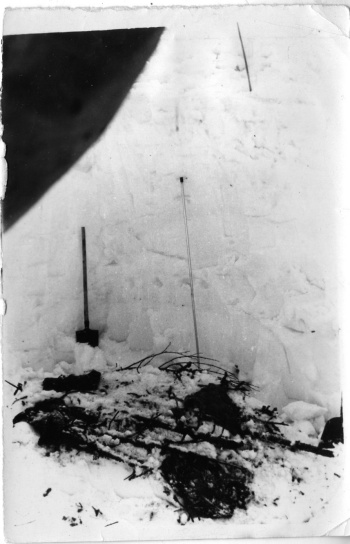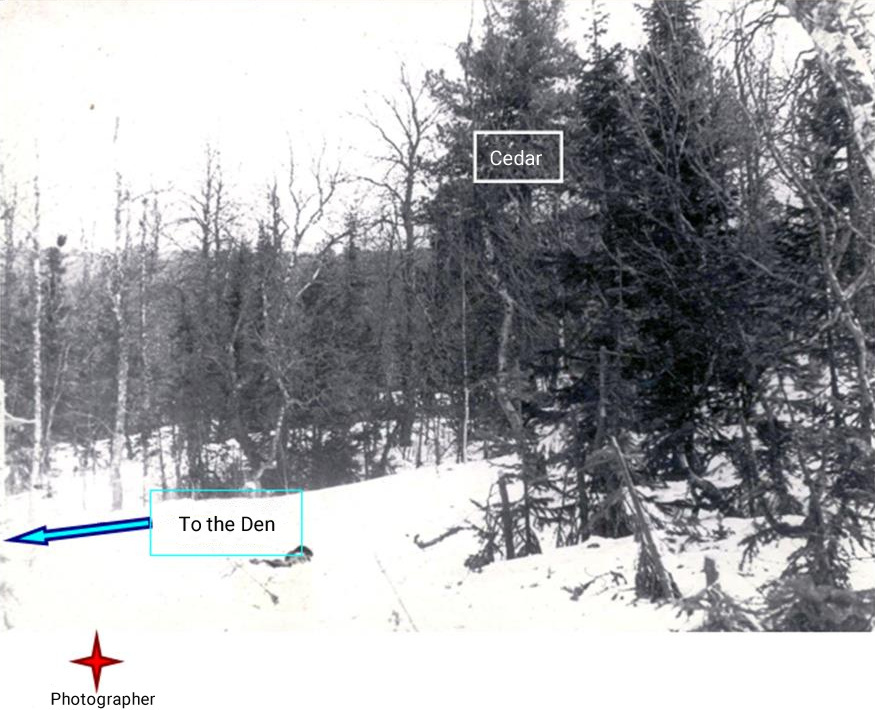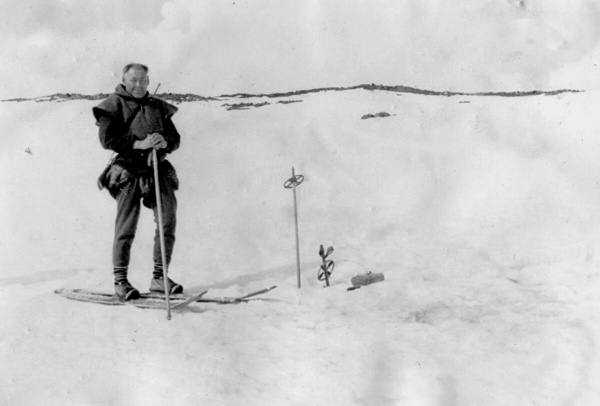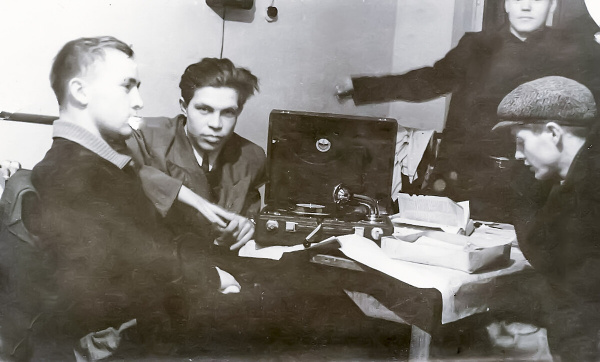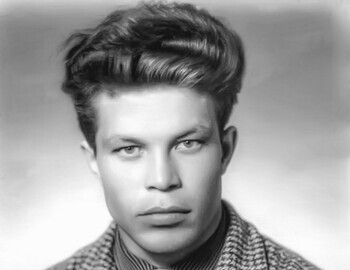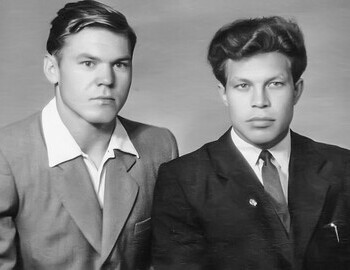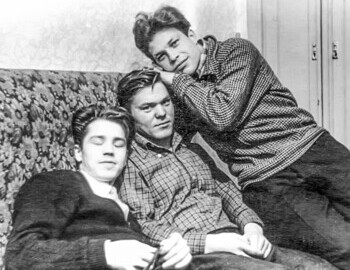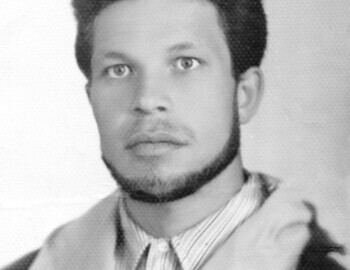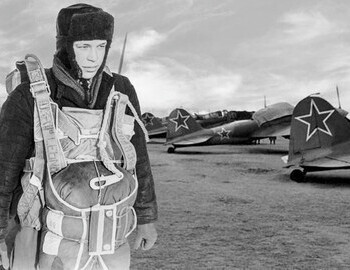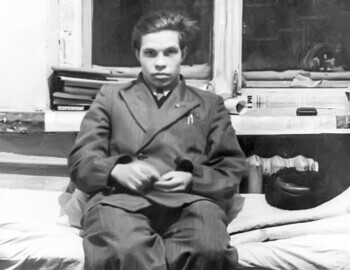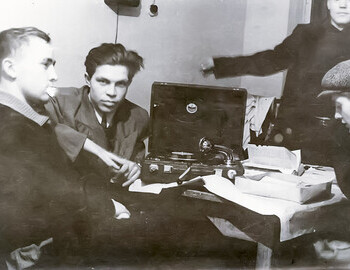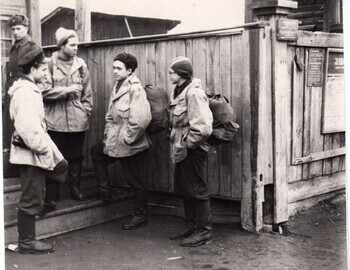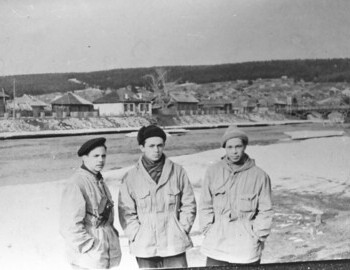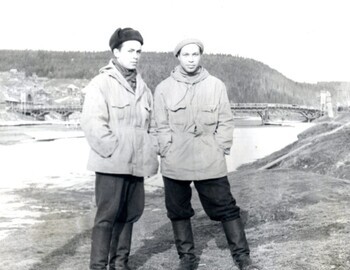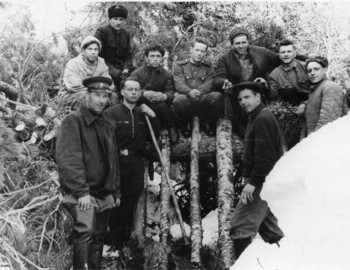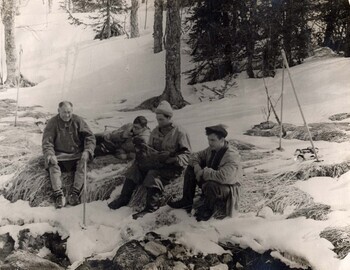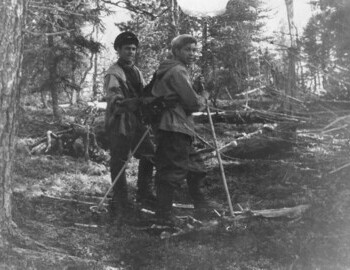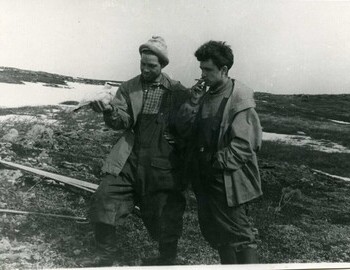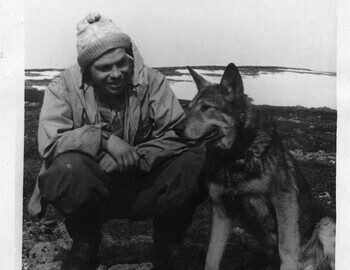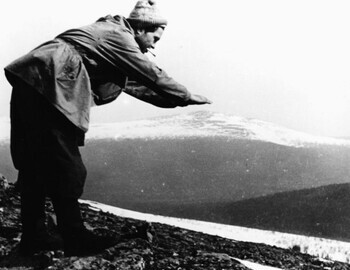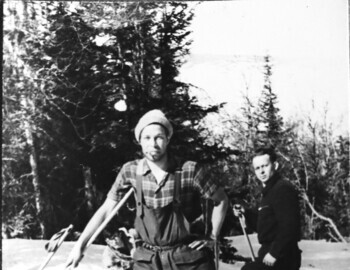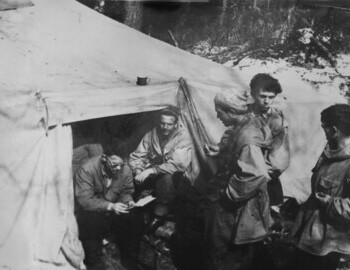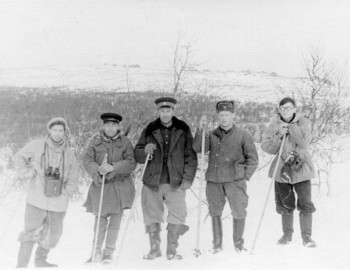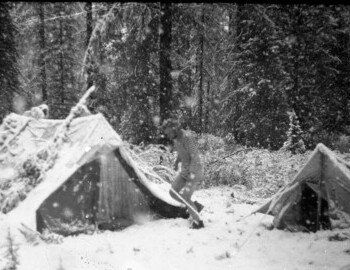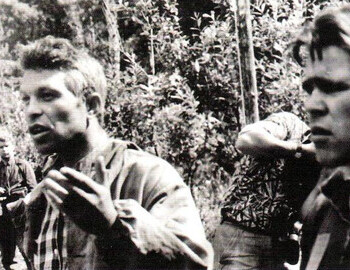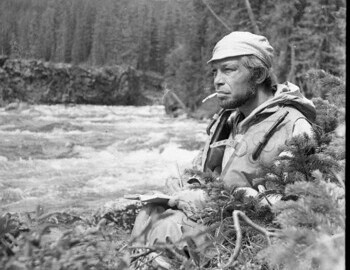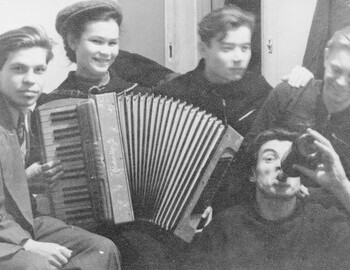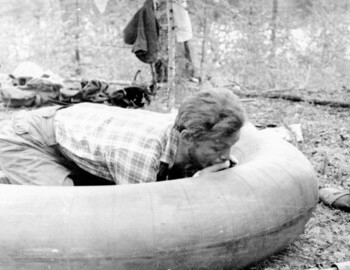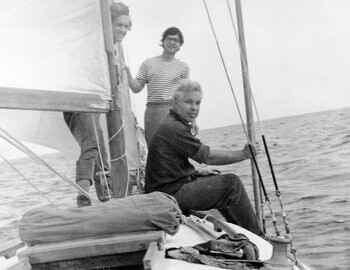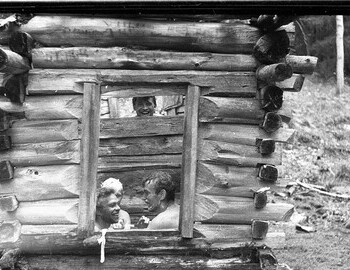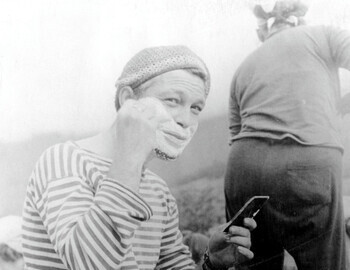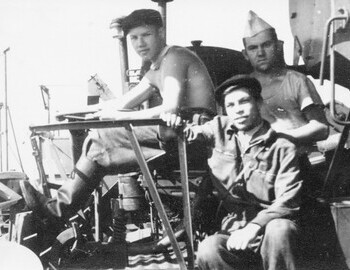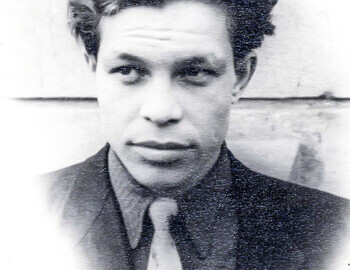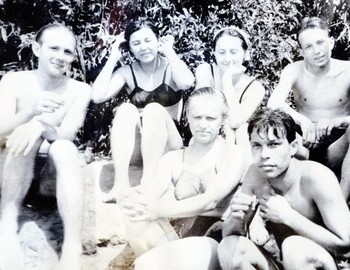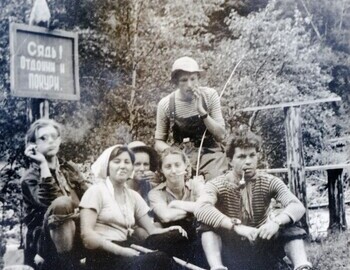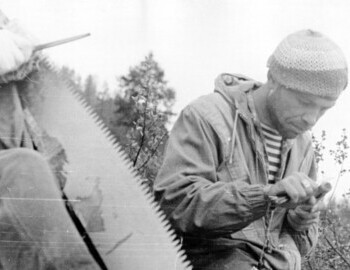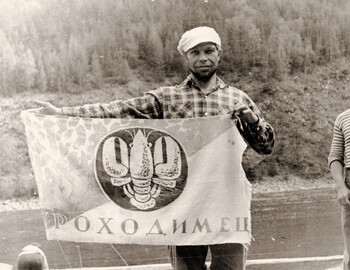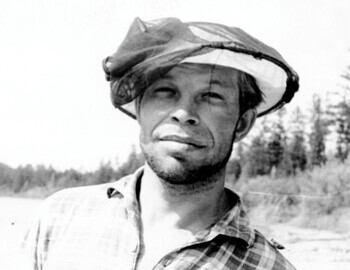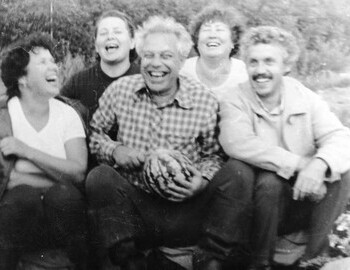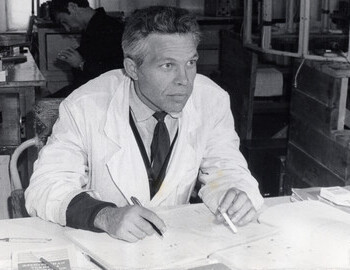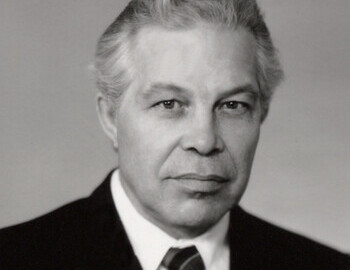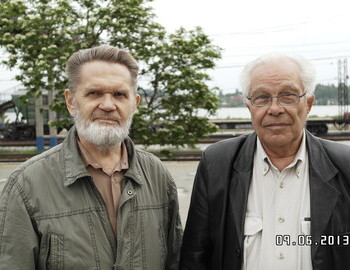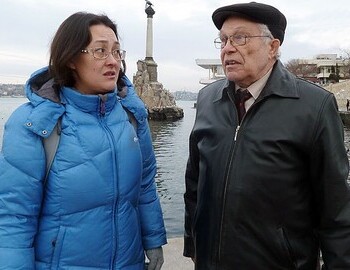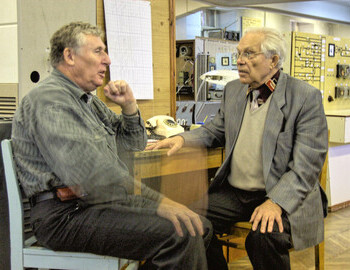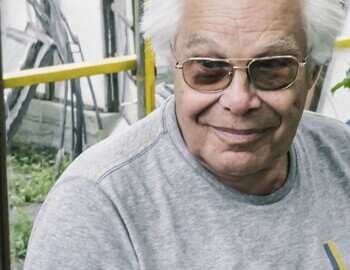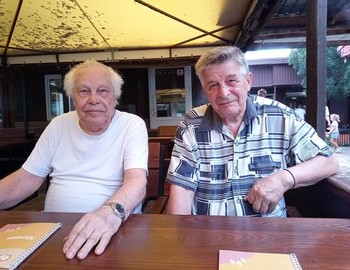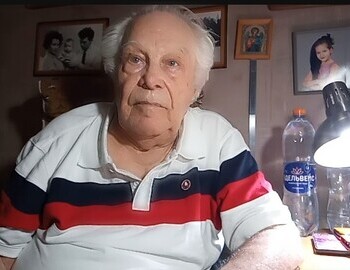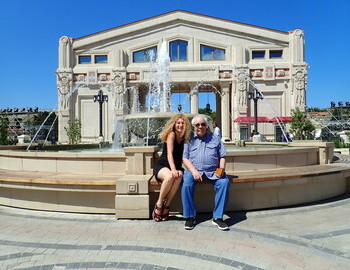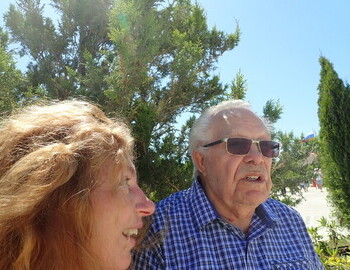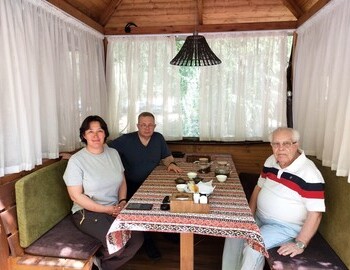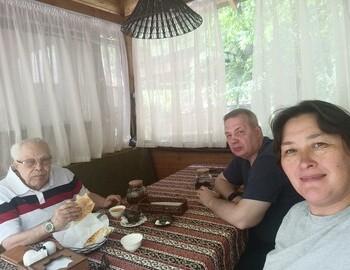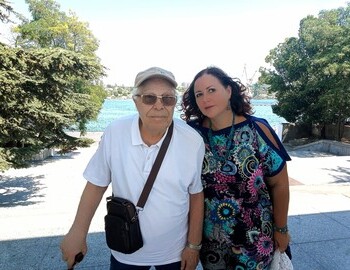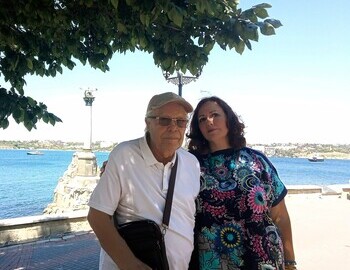
Askinadzi. Selected passages from letters - part 1
Head of the UPI search party Apr 25 - May 8
Maya Piskareva. September 10, 2014
In this publication I present some of the information that I have accumulated as a result of correspondence with Vladimir Askinadzi in recent years.
* * *
VLADIMIR ASKINADZI:
The armchair theorist is not you personally, but your entire generation, who only have to crawl to the truth from photographs. And the further you go, the more boring it will be.
As for route books.
I would not like to engage in a thankless task like commenting on why the Route qualification commission ("Route commission" from here on - ed.) did not keep one copy of the minibus for itself. Apparently, then the approval of the most difficult campaign was reduced to an empty formality. This is inexplicable from the standpoint of common sense. And feel sorry for yourself and don’t rack your brains.
The general rule for preparing route books was this. I repeat, general, since there were local nuances.
The manager filled out all the pages of the book, indicating, first of all, the route and target dates. In addition to the main route, backup options were always indicated in case of something unforeseen, again indicating new deadlines and points of departure. Next, a list and quantity of products, a list of equipment, etc. were indicated.
The route book was a form - a booklet where the tables were already indicated; they just had to be filled out and preferably without doing anything on your own. If a handwritten line appeared in the product table, then it would be advisable to indicate whose recommendations the manager used. At that time, Okladnikov's Traveler's Handbook was held in high esteem. Everything that a traveler needs to remember was described there in chapters. There were recommendations on how to properly pack horses. There was also a chapter on products. So, practically without thinking, they tore everything out of there. Nobody was interested in what they actually took with them. Only the manager was responsible for everything!
Forms of route books were freely lying in the tourist section of the institute. Nobody took them into account. Anyone who was going on a hike as a leader came and took as many of these forms as he wanted, even 10 pieces! They became a registered document only after the Route commission seal.
The leader, in particular, Dyatlov (regarding Sverdlovsk residents), went to the city Route commission and "filled in" the date for consideration of the route.
Without route books, he had nothing to do at the Route commission, because they were only considered.
On the appointed day, the leader, alone or with a group (part of the group), came to the meeting of the Route commission and reported everything that he considered necessary. If members of the Route Qualification Commission (Route commission form here on - ed.) had questions for him, he answered. If everything was fine, the Route commission protocol was written, and the route book was signed by the Route commission chairman. The manager received one copy, the second one remained, or was supposed to remain in the Route commission, the third was supposed to remain in the controlling organization (at Gordo’s institute). The route book number was determined by the priority of consideration and must coincide with the protocol number and registration number in the journal.
You see, what happened BEFORE Dyatlov and what happened AFTER, as they say in Odessa, are two big differences!
After the Dyatlov tragedy, documents must also be reviewed by a consultant from among experienced tourists before being submitted to the Route commission. But this is after, when I’m tired of burying corpses. For example, I was a consultant on water treks of the highest category in the Sayan Mountains; the Route commission did not consider documents without my signature.
A copy of the Route commission protocol was not supposed to be transferred to the controlling organization - this is an internal document of the Route commission.
According to your assumptions, if Dyatlov intended to manipulate the facts for one reason or another, it means that he was going to go where the Route commission would not have allowed him (a possible reason was the lack of qualifications of some participants). But in any case, he should have come to the commission with three copies, and one of them should have been withheld by the commission from Dyatlov without asking him. But the sloppiness progresses from case to case until the situation explodes! It exploded with Dyatlov group, only to be reborn three years later, having lost more than 200 people, like a Phoenix bird.
Forgetting to take one copy to the institute is a common mistake, but allowing not to leave a control copy at the Route commission is a grave omission of the City Committee for Physical Education and Sport, Ufimtsev. Surely the reason why all three route books remained in the group was the inexperience of the Route commission members, and the unsettled rules and responsibilities of the Route commission itself.
It is difficult to find any logic in this general chaos.
Theoretically, Dyatlov could take two route books with him. I practiced this myself. But I was a water sportsman, and in order to preserve the route book when there is water all around, it is better to take two and pack them in different waterproof packages. With Dyatlov, I think everything was different. He discovered that he took one too many route books with him already on the go; he had no problems with keeping them dry i.e. separated.
Although Maslennikov's requirement the qualification of the members of the group to be written down could have been the reason why Dyatlov didn't leave a copy at to Route commission, presuming that after the trek he will figure out the hiking ranks of his people. Dyatlov simply did not have this information. After all, at the time the treks could be approved even after its completion (we are all living and compassionate people), if everything went well! Of course, provided that the route book had stamps of the starting and ending points of the route. For example, I was approved for a hike along the Kola peninsula 5 years after completing it.
1959 Regional hiking tourism began in 1954 and the founders were Vsevolod Poluyanov, Victor Bogomolov, Moisey Akselrod and other "old men". My first trip was in 1956. We started from scratch. There were no guidance materials. The only Master of Tourism in the region was Evgeniy Maslennikov. A little later, Moisey Akselrod became too. Learned from successes and failures. And the tragedy of the Dyatlov group was the first major tragedy on the scale of the Union, and especially the region. Yes, there were corpses before them, but only a few. Analyzed and made conclusions. But we must not forget what time it was then! This experience could not be shared because there was no access to the media. No one would undertake to print such material. In the Soviet Union at that time there was not only no sex, but also no accidents!
Novikova’s role could be anything, for example, a medical consultant, or for a quorum. I don’t remember Novikova herself, although we probably could have met.
- 2 -
After the last bodies were found, a purge began at the institute. They began to fire everyone who was in the slightest degree involved in this event. Gordo, the Chairman of the UPI sports club, was fired, despite the fact that the institute teams, for example, in women's volleyball, parachuting, weightlifting, etc. were the backbone of the republican teams. I met with him literally in his last week. He meets me in the corridor, invites me into his office and sincerely says, what should you do to say goodbye? Do you want a "Ready for labor and defense" certificate - 2? I didn’t really need it, and he had nothing more to thank me for. So I got a fake ID.
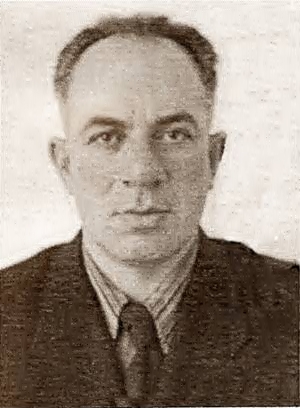
Lev Gordo.
The Sports Council at our institute united all the numerous sports sections: hiking, mountaineering, volleyball, auto, motorcycle (there were some), parachute section, etc.
Trek project
This is more extensive information about the hike than the route book. The route book form contained tables indicating, for example, food supplies, and their quantity was indicated by the manager. There was also a table of group and individual equipment, a table of repair kits, etc. Everything was formalized, so in the route book they wrote one thing, but in fact they took both in quantity and in assortment - whatever they could or wanted.
The trek plan was prepared in parallel with the route books and written in a student notebook. It indicated everything that the leader knew a priori about the hiking area, possible dangerous places and methods of overcoming, possible places for replenishing food, and, if known, outstanding landmarks for dangerous areas. In a word, indicate everything you know. This will count as a plus for you!
Why should Ufimtsev, according to the rules, sign all copies, but why did he sign only one? I have no idea. Someone (??) signed all three copies for me. Why "someone" I don’t know, since I came to the meeting at the appointed hour, there were several people sitting who never interested me, and I didn’t remember them, since they changed quite often, in my opinion, annually, and I I attended meetings once a year. Whether it was from Ufa or someone else, the main thing for me was to get not so much someone’s signature as the seal of the Route commission. For others, I think was the same.
The route sheet was given only for non-category trips, weekend or single trips, the route book was a document "with stamps". It should contain stamps of the beginning of the route, usually placed at the local post office, and the end of the route, also at the post office. If an intermediate point was also declared during approval, then it also had to be confirmed with a stamp.
About the control dates
They were always treated calmly, especially regarding the starting date. The date of the end of the trek is a sacred matter, and the beginning, especially earlier, is not a crime.
By the way, a small clarification. Route sheets instead of route books were issued signed by Gordo only for "one-off" trips and weekend trips. Five weekend trips were considered category 1. The Route commission approved hikes of category 2 and 3.
If I were the Chairman of the Route commission, I would not say anything to anyone at all and would not make excuses. Formally, the Route commission allowed one group to enter the route, but in fact another group left, the composition of which was not considered by the Route commission. The Route commission did not consider the qualifications of the supplemented members. There are no complaints against the Route commission in this situation. But this, if we consider it formally, from the position of who should go to prison.
And so, this whole epic had absolutely no impact on subsequent events.
Now,
Regarding the qualification indicators of any route.
Never before have any guiding documents on hiking specifically formulated the details that determine the qualifications of a trip. It was always based on only one indicator - mileage and population along the route. And that's it!! Everyone knew perfectly well that the same route taken in different years can differ significantly from one another! Sometimes, because of the rains, the high marshes turned into difficult-to-pass areas, although last year they were almost dry places. The depth of the snow cover sometimes forced the hike to be delayed for several days, which then had to be proven to the Route commission after the hike.
Since tourism was massive, as a result of tourist statistics, areas with extreme difficulty of hiking were identified. In the Middle Urals, a ski trip of category 3 would never be approved, just as a water trip of extreme difficulty would never be approved in the Carpathians. These areas were called by category. The Sayans are a five-star region for water routes, the Pamirs for hiking routes, the Subpolar and Polar Urals for ski routes. But the Northern Urals are only a four-star region for skiing. And even if you walk along the watershed all the time, you won’t get to the highest category.
Sometimes the same water guides included an ascent to some associated peak (Grandiozny and Podnebesny peaks were popular in the Sayan Mountains), but this was not counted as a complication of the route. Everything was determined by the river.
- 3 -
They invited everyone who knew the Dyatlov group to fly over the territory, but Yudin was not involved. Why is that? Yudin insisted that he was not taken to fly over the territory and was not interested in him as a witness who was the last to see the Dyatlov group alive for the reason that Dyatlov did not tell anyone about the route they were going to, like hiding his plans from the group members. Is this acceptable for a leader or not?
It turns out that Blinov knew about Dyatlov’s plans, although he parted with him in Vizhay, and Yudin, who reached the Second Northern with the group, did not know where they would go next? Yudin didn’t know where the group was going?
I don’t know when Yuri Yudin appeared at the institute. We first met him at the ski base of our dorm, where we were sorting out the belongings of the Dyatlov group. It was, in my opinion, in the second half of March, maybe even later. Regarding the fact that Yuri Yudin did not know where he was going, he still wasn’t talking about anything. He just didn't want to know. They lead and he follows! In principle, this could not have happened that the leader was hiding even the details of the route from the participants. How is it that Krivonischenko, not knowing what awaits him, took off and ran away, not knowing where! Everyone knew everything, since they had discussed the details of the trip more than once even before leaving.
To take a person on a hike, he had to visit several doctors. But the leader, at his own peril and risk, can take some chronicler if the group really needs him. I was once forced to take one. We just needed a cameraman in the group. By the way, for the film that he shot, in the "Film Travelers Club", led by Shneiderov (before Sienkevich), we received a second prize with a certificate and a coffee set for 6 people. We took it apart into items. As the author of the script, I got a coffee grinder - it is still alive. In 1962 we were on the Kazyr river (Central Sayan). A very successful film was shot there. And in 1963 there was an all-Union screening of sports films. Our film was in color (at that time the exception, not the rule). We thought that Vladimir Adolfovich Shneiderov would show it on television, but he refused us, saying that the film was too scary for the average person. Very impressionable spectators may faint.
In general, judging by the actions that are attributed to them and the disunity of the group at the time of its discovery, it looks like the Dyatlov group acted like rookies who went on a winter hike for the first time, everyone went their separate ways, they could not light a fire, they could not build a shelter... This despite the fact that all of them aced hiking and trek leadership. A strange picture emerges for simple freezing temperatures and snow falling onto the tent.
You are right that much about the Dyatlov group behavior remains unclear. Something very extraordinary happened if no one can understand for half a century what really happened there. Because of the cold and something else, everyone's attention was focused on their own problems. Dyatlov could not raise as a leader in this situation. I repeatedly tormented myself, trying to imagine what kind of situation could stop me at a difficult threshold, but sending my friends there. I couldn't imagine such a situation. That is why he is a leader, even in a dissimilar group, to be at least half a step ahead of the events in his decisions. This is an instinct, can not be thought. You either have it or don't go as a leader.
The conflict between leaders is obvious. I wouldn’t even call it a conflict of leaders, but rather that Dyatlov’s leadership style was unacceptable for the newcomer, Zolotaryov. While others expected and were ready for Dyatlov’s tough leadership style, the newcomer did not. Two or three remarks and the group fell apart into supporters and opponents of Dyatlov. It must be assumed that Dyatlov himself was shaken as a result of this.
Let's try to analyze why the group split? Let's just be honest - these are only our conclusions, dictated by our understanding of what decency, mutual assistance and, if you like, respect for each other are.
If we assume that by that time everyone had isolated himself only in his own diary, the situation is obvious, there is no need to analyze here, everyone fends for himself. No one has ever imposed on a leader who to invite and who not to invite. And there were never any guidelines on how much and whom to take. The leader always decided everything. In terms of the obvious and hidden factors that played role, anyone can be blamed if the group consists of random people, or random people make up the majority, or, which is much more common, the leader does not control the situation, is not an alpha leader.
I speak from my own experience. Anything can happen, especially on a difficult hike. It can be made even more difficult by poor preparation. The slightest difficulties, not even so much difficulties as petty, frequent hiccups, can throw both the leader and the group (where have you taken us?) out of balance. It happened to me too!
But let's still be lenient. They spent almost six hours together in the cold and darkness. They fought as much as they could and as best they could together. And when they lost all hope of getting fire, they began to crawl away. Another thing is that the whole group had to try to return. In this case, you can support the weak, even if not so much physically as morally, by your own example. "Well, come on, my friend, let’s take a couple more steps. Well done. Give me at least one more. Smart girl. There's just a little bit left, let's take a couple more steps. Well, now the tent is visible. Well, let's be stubborn for the last time. I will help you!" And his hands are already frostbitten, his face and nose are frostbitten, and he encourages the guys. This is how, in my understanding, a leader should behave if he promised them to return from the trek alive and all together.
It was not the instinct of self-survival that put them in such a state, but different physical forces. Zina was the most physically strong. We fought with her as a joke. After that, I became the object of bullying, although only for one trip. She was the one closest to the tent.
Why did this terrible tragedy happen specifically to Dyatlov group, and, for example, not to Sogrin group, which was passing nearby and at the same time? Or in other words, why did everything happen only with the Dyatlov group? Who didn't like him? Why didn't they like him? Why did they leave Sogrin group alone? How does Sogrin group differ from Dyatlov group in terms of interest in crime? Enjoyed unexpected revenge? I don’t mean the literal parallel passage of Sogrin and Dyatlov. I say that they were practically in the same area, only they killed one and left the other untouched. I was also in the same area (in the Man-Pupy-Nyor area). Why didn't anyone scare me or touch me? Were they afraid that I will fight back???
Even in ancient Rome, in their Roman law, it was said: "if you want to solve a crime, look for who benefits from it?"
- 4 -
You are all seekers, looking for petty facts, stubbornly (or out of illiteracy) avoiding the main question: who should have been killed and why, a group of guys who were absolutely harmless, from the point of view of reciprocal aggression. Well, walk past without touching each other. Say hello, smile at each other, and continue doing your job. Oh, did the guys find out something top secret? Wait until they return to Sverdlovsk and scare them with non-disclosure if they spill the beans about where they were and what they saw.
And this is only part of the questions and only in the "crime" section.
Other sections, except for "the elements", require answers to even more questions.
And there is no cynicism in this. Vital questions, without which it is impossible to understand the cause of the tragedy.
I don't want to go deeper into the problem.
I’m not a careerist, but if I were entrusted with managing the entire search problem, I would do it systematically and competently, without hesitation or hesitation.
And the answer is simple - either there was no one, or the authorities at that time had nothing better to do than pester tourists.
But if you accept a different version, then there will be more plausible situations.
And now the system analysis method (its fragment)
It works great in conditions of low information content, when there is no initial or reliable information to start research.
Initially, a hierarchy of problems is built from top to bottom:
Contradictions
Problems
Goals
Tasks.
We won’t deal with contradictions - this is not the right level. These are, as a rule, contradictions between labor and capital, between the government and the people (everywhere), you and a potential enemy, etc.
Problems
1. Why the Dyatlov group?
2. Why in 1959? Hikers have walked in this area before.
3. Why are there different types of injured guys in the group?
4. What were they kill with?
5. Why were they killed?
6. Who killed them? Planned event or spontaneous (like Tiunov)?
Each problem gives rise to a tree of goals, having achieved which, the problem can be resolved.
Goals for the first problem.
1. How is the Dyatlov group significantly different from other groups, why should it be killed?
2. Have they entered a forbidden area? Why were there no murders in that area either before or after?
3. Dyatlov recruited too pretty hikers (according to Tiunov) and someone really wanted to sleep with them?
4. A dozen more goals can be formulated for the first problem.
Each goal gives rise to a task tree.
For the first goal:
1. Is there a suspicious group member?
2. Are there too many girls in the group?
3. Who is missing from the group? Etc.
And this is a small fragment of the plan for system analysis.
Each problem is described in detail, the corresponding goal trees are pulled out, task trees are formulated, and the routine work of sometimes a large team begins.
Without solving the top level of at least one problem, don’t go lower. Without understanding who benefits from this, it is useless to determine the magnetic declination in that area or count Zolotarev’s teeth.
Tired? What did you think? Do you think a fundamentally new weapon is being created to the cry of "Eureka"? This is 95% routine. Each service draws up its own plan, corresponding to system development.
All your questions would be interesting if there are already answers to some problems. And at this stage, for example, I don’t really care how many passports and work books anyone had. This will be interesting in due time, at its stage of research, and not now.
This is the systematic approach I was taught. This is the systematic approach I taught to students. I've been designing new weapons for 30 years using this systematic approach.
Now it’s clear why journalist Grigoriev saw confusion in the initial period of his search. Everyone wanted to find the answer without spending a lot of effort. The lack of system led to insoluble conflicts, including with the authorities. And there was no "a la Kurchatov", who usually declared: "If you know more than me, sit in my chair", even to Beria’s envoys.
Everyone was rushing about, not understanding which direction to run, instead of locking themselves in a hotel for two days, collecting their brains in their hands and drawing up a systematic work plan. It was even possible to approve him in the regional committee, so that later they would not pester him. Otherwise they gathered several groups in one place and hit them head on. They only got in each other's way.
And don’t get involved yourself, you’ll overstrain yourself, you won’t have enough strength or capabilities, since the train has already left today; Today no one needs it. It would be timely to do this no later than 69.
No empty spaces should be left in system analysis; everything should be clear at the appropriate stage of research.
- 5 -
Well, at least let’s take a small piece of the problem as an example: who needed to kill them?
It is absolutely impossible to kill without leaving a legacy.
The authorities absolutely do not need this murder. The next party congress was opening in the country. The country needs calm. And for the authorities, if someone needs to be quietly “sewn down,” there have never been any problems.
So, we exclude Power, and we will not talk about it anymore. We exclude planned murder.
Spontaneous murder remains.
Then we must admit (which we really don’t want to do!!) that the men in the group turned out to be cowards. The girl is broken rib after rib (it’s impossible to break 10 ribs in one fell swoop with improvised means), and the leader not only does not protect her, but also does not receive a single scratch. Who protected her??
At this stage, it doesn’t even matter why they were killed and who killed?
Should we discard spontaneous murder or not?? Why the hell should murderers go that far? If you really want, you can find everything much closer and faster, especially in winter.
General Shishkarev arrived... it’s already warmer.
As for spontaneous murder, you can invent another 150 options - you need cause and effect connections between events, that’s where the zest comes in.
I've been in a sad mood for the last two days. And this sadness was brought about by Zina’s letters. Amazingly strong girl! If I were her, I wouldn’t dare to go in Dyatlov’s group, I simply wouldn’t have the nerves. Not courage, but rather nerves. After all, that winter there were several winter category 3 treks, not only Dyatlov and Sogrin. They would have taken her anywhere. By the way, many people liked Zina in the dorm, and she probably guessed about it. But I don’t remember that she even left the institute with any guy - either alone or in a group of guys. Therefore, I think Doroshenko should have reciprocal, or maybe not reciprocal, but mutual, feelings for her. A lucky man whom such a girl fell in love with!
I read and thought that nothing had changed in 55 years, as if the letters were written yesterday. And I imagined the dorm, where each floor smelled differently.
A blind person, knowing these smells, would never get lost.
You don’t know how many people later credited themselves with the opportunity to go with Dyatlov, but it didn’t work out. Peculiar Children of Lieutenant Schmidt.
To my shame
About the funeral
I know infinitely little. I didn’t know anyone except Zina.
Zina's coffin was displayed in our dorm foyer. The "guard of honor" was spontaneous; those who wanted stood as long as they wanted. I stood for about 10-15 minutes. Zina’s face was calm, without visible external injuries, but the color of very thick chocolate, even with a slight blue tint.
The foyer in our dorm is a walk-through and Zina was only lying there in the second half of the day.
I don’t know who put it and when. When I came home from the institute, she was already lying down. I went into my room, stayed there for a while, then went downstairs, someone was standing at the coffin, I didn’t even pay attention who. I approached the coffin. The face was not entirely familiar. I had to sit down a little to see the profile. Yes, there was Zina. He stood... without looking at anyone, and went to his room... The next exit to the foyer was only in the morning. There was no coffin. When they took them away, how they took them away, who took them away, I didn’t see.
This is the whole truth.
In the dorm there was only Zina’s coffin, and only because she lived here and had no other home. Did any of the relatives stand at Kolmogorova’s coffin? No, there was no one there except the students (at least while I was near her). When I stood there were no wreaths at her coffin. Maybe they brought it later?
Rustem's single felt boot is the result of a panicked abandonment of the tent, when those who ran out after him simply did not let him take a second one. When the crowd breaks and one falls, he is not allowed to rise and is trampled. From this alone we can assume that Rustem was among the first to leave the tent.
Regarding your version of the four getting fractures and injuries in the ravine. Here are my two cents: modern histology is not yet able to distinguish whether the injuries were postmortem or pre-mortem. Moreover, the bodies of the four were in severe decomposition. So the histological analysis, if presented in court, would not prove anything. It is incomplete and does not answer the question of pre-mortem injuries. Because exactly the same results are observed in corpses after death. But Vozrozhdenniy points out that the deaths of Dubinina, Zolotaryov and Thibeaux-Brignolle were caused by the injuries they received. This means pre-mortem.
I ignore the histology results because if they are taken into account, it is impossible to create a single picture of events. Something has to be sacrificed. In life, such events happen all the time. If Copernicus had not choked on the contradictions of Ptolemy’s geocentric model of the solar system, which existed without criticism for 2000 years, we would still consider ourselves the center of the universe. So they would gawk at the cycles and epicycles of the planets. Vozrozhdenniy did not have the conditions (and perhaps even the desire) for a serious conclusion, but he needed to write something!
- 6 -
If we take into account the results of histology, then we must admit that what happened to the group has a large time gap from the moment they left the tent until the last breath of the latter; two events almost unrelated in time, which contradicts the climatic conditions that existed at that time. I do not insist on my version, but without it the can't finish the picture.
After reading the new statements from doctors and forensic experts about the cause of the fatal injuries of some of the Dyatlovites, have you changed your initial opinion?
The opinion about the cause of the injuries has not yet changed. Yet!! In one of the letters (I don’t remember where now) I said that if a more convincing version appears, I will abandon mine.
Some are perplexed why Igor Dyatlov needed to cache on Auspiya? Why not go over the pass with all the supplies?
This is very similar to the nonsense of my former bosses, who seriously believed that the remaining four Dyatlov group could go to America through the North Pole! This can be said by people who absolutely do not understand how long even a trained athlete can stay autonomously in the winter taiga. Have everything in your backpack: a pair of warm, dry underwear, dishes, an axe, preferably a saw, in order to quickly organize an overnight stay and have more time to rest, food (there were no sublimates then), weapons, at least for hunting, medicines, a set of tools for minor repairs and other small items. What is the maximum load you can load a trained man? You can’t carry more than 45 kg (I know from my turbulent youth!!). Either a lot and for a short period of time, or a little and... also for a short period of time. The group will not be able to live for more than two weeks!
You should also take into account the short winter days!
Even the most difficult winter hiking trip is tied to the population in case of an emergency. It should be no further than a 2-day trek with lightweight backpacks.
And Dyatlov left 60 (!) kg of food at the cache site, which means he took an average of 6 kg from each person. You can experience what 6 kg is by going to the market. And this is in addition to the remaining kilograms! This means that I planned to travel lightly to the summit and return in one day. Without a cache site, he spent at least three days on this same goal. Here is my vision of this version.
Alternate routes are selected in advance and approved by the Route commission before departure. The purpose of such routes is to evacuate the group in case of force majeure on the main route. There are usually several of them. They must answer the question: how will the group go out if something happens on the first half of the route (a participant gets sick, a serious accident with equipment, etc.), in the middle of the route, at the end of it. Alternate options should exclude, if possible, any difficult areas.
What do we see now? These are not evacuation routes, these are backup routes to the main route, which was never allowed, because then no one will know where to look (God forbid). I, as a possible member of the Route commission, would force Dyatlov to decide which route is the main one, and which ones - just in case.
Yuri Koptelov claimed that searchers later moved the camp down the slope. This statement is incorrect and is not confirmed by other searchers. He knew nothing about Dyatlov’s camp then. It was taken out of the pass before the cache site was found.
According to Karelin, Dyatlov’s camp was 800 meters from the search camp, higher up the Auspiya valley. Karelin participated, at the command of the search headquarters, in the construction of a helipad for receiving helicopters near the search camp. There are a lot of different conversations going on about this "airfield" now. Karelin said that they trampled the snow and cut down trees at the level of the trampled snow. Valentin said that some of the stumps up to 1.5 meters high were still preserved, and that there were photos of him from the expedition to the pass in 2012. But the pilots rejected this "airfield" and it was never used.
Why do you think all Maslennikov’s diaries, which he kept during his search, are not published? Maybe there is something written there that the public should not know?
If there really are Evegeniy Maslennikov’s diaries, then I don’t understand why they are hiding them if they are not going to be published? After all, the rules of searchers are: if you find something new, report it. It may very well be that there is something to hide, not because someone is bad or did not work well in the search, but because at that time everyone was living on nerves, and Maslennikov, in the heat of the moment, offended someone living today in his personal diary, being convinced that no one will read it. For example, in my diary I mentioned Ortyukov twice when he drove us out on a route in a snowstorm and almost forced us to work on the May holidays.
Things have happened in the search!
I really regret that my diaries disappeared. I remember the day when the authorities arrived (5.05), I described it on three pages in small print. And, most importantly, on the freshest tracks. I remembered the details of these two days for a long time, I thought it would be for the rest of my life. Shit, memory rusts, especially over the course of 53 years.
About the title Master of Sports
Were there any monetary bonuses given for receiving the USSR Master of Sports in Tourism? What advantages did this title have?
At one time it worked, but in 1956 Khrushchev canceled them. Preserved only by those who worked in sports. Zolotaryov, for example, could receive a bonus. The rest were only moral satisfaction for themselves and, of course, were proud of the public assessment of their skill.
For some it really didn’t matter, but at that time an employee in a sports structure with the title of Master received a salary increase. Therefore, from what position should you look at it? I was very proud of this title. Being recognized as a Master of your sport is always warming.
It seems surprising to me that investigator Lev Ivanov, without archival records, after 30 years, was suddenly able to write an article and quote from memory the testimony of witnesses, the same notes about fireballs, time, date, names... He probably had a copy of the case files at home. How else can we explain the fact that Ivanov quoted the case materials from memory, accurate to commas and periods?
- 7 -
As for Ivanov himself, he probably wrote his article for more than one day. He remembered the main thing well, because even after the case was closed, he worried and analyzed the events for a long time. I know from myself (after 53 years), it is enough to remember 2-3 dates, and the rest line up on their own in accordance with whether it passed before or after a given date. And, if you think about the same thing for several days, then there is no difficulty in remembering it or other dates. Your first letter made me despondent. I thought that everything was completely forgotten. But, immersed in the atmosphere of those years, the events floated out of memory by themselves.
I wanted to know about tickets, how they were issued at that time, manually by a cashier, or were there some machines that printed tickets- squares, etc. What was written or printed there, was it really the destination, or just the zone number and price? Why does everyone say Serov, and not Nadezhdinsk, even in the diaries of the Dyatlov group mentioned Serov.
We bought tickets to the city of Serov and we did not know any other names of it. This means it was renamed quite a long time ago. And on the maps that we had, this city was called Serov. Although we knew that this city was named after the hero - the pilot.
Small cardboard tickets have been in circulation since tsarist times. The destination station and the numbers of trains, cars and seats were imprinted on them. The specific numbers themselves were entered by hand and the date of departure was entered with a special punch. That’s why the cashier had a cassette tape on all the stations in her area hanging on the wall. Need Ivdel, she took a cardboard from a stack of Ivdel tickets, wrote down the train, carriage and place and punched the date. Before Ivdel in Serov we received small cardboard boxes and were very worried that before Ivdel no one checked them. Student habit of traveling without tickets.
We had a very different life. Why is it now possible to buy round trip tickets, etc.? service? Yes, this is a consequence of computerization, when all cash registers are linked to one database. In our time, in order to transit through Moscow, you had to stop and validate a ticket for the train going further. This sometimes took several days of living at the station. Sometimes, several hours before reaching Moscow, aunties would walk around the carriages and sell or stamp tickets. In their suitcases there was a huge stack of live tickets. There was no practice of buying return tickets.
Yuri Yudin must have taken care of the return ticket himself.
By the way, we once traveled through almost a third of the country without tickets, but legally. We traveled on a cargo train from Tashkent to Orenburg, returning from the Fan Mountains, having agreed with the guards of the train, who were traveling in the last carriage. We went with them.
About the ravine, den and sides.
Were they there or not? And if not, why not? Did the branches of the conifers go down far?
In our time there was no ravine, everything was evenly covered with snow. In their time, the ravine was covered with a fairly thick layer of snow. And during the excavation, apparently, it was possible, if desired, to examine some kind of heterogeneity in the walls of the excavation, but we had no time for that. There were no obvious, conspicuous signs of irregularities on the walls of the excavations. The branches reached right up to the den, lay on the surface and were green.
One of the initial episodes of digging the upper trench. If you remember, there is a photo where about 10 people are standing in a finished trench? It seems to me that this is that trench, although there is doubt. I’ll say it again about the excavations: I can’t tie them to the area; they’re suspended in the air.
The den was not touched on purpose until the authorities arrived. And when they arrived, a commotion began with the corpses....
As for the thickness of the snow under the den, no one checked this, but the den could easily support the weight of three people. There is a photo circulating somewhere where Suvorov is standing on the den. I think there was about half a meter of snow under the den.
They lay, judging by the den, about a meter above the bottom of the stream. They fell later.
As for setting up a camp in the forest under a cedar tree, this is the only thing that could save them. I discussed this with Valentin. His assumption is that Dyatlov decided to experiment and organized a cold overnight stay. My position is that you need to experiment either on training trips, or when there are no emergency symptoms, for example, very low temperature.
I was especially touched by the ranting that the den was made by someone, and not by the Dyatlov group. They say the Mansi were waiting out the weather. No fire? With other people's rags on the den? And then how did this happen? Hugged and warmed each other? Kurikov made a fire instantly out of nothing, I saw it.
- 8 -
They were the ones who justified why the guys were not on the floor, but nearby. I sent you a photo of the den, on which there was a dark spot in the upper left corner. This is a tarpaulin that we used to cover three guys from the sun. The size of the tarpaulin was 2x2 m. Where are the 6 meters that the author counted?
Let me explain about the tarpaulin over the guys.
Firstly, the tarpaulin covered not Lyuda, she had been lying aside since the evening, but the guys’ heads. They were counting on the worst, that the authorities, especially Sverdlovsk, would arrive late; the sun was already heating up quite intensely. We did not touch the bodies till the investigators arrived, only pulled a tarpaulin over them. The famous photo was taken from such a point that the far right corner of the tarpaulin, when viewed from the guys’ side, was projected onto the excavation site. But this does not mean that he was actually above the excavation site. It is necessary to take into account the parallax of the shooting point.
Therefore, those 6 meters that were measured from under the hand must be adjusted downwards, for example, to 3.5-4 meters.
It turns out that when you dug up the den, you trampled around within a radius of several meters and probably over the bodies of the Dyatlov group?
Yes, we trampled during the excavation, but not on the bodies, but on the guys’ legs.
Who first came up with the idea to build a dam on this stream, where the guys were later found?
I don’t remember exactly whose idea it was, but Ortyukov gave instructions and showed the location of the future dam.
As for the notebook and pencil in the hands of allegedly Zolotaryov
There was no problem taking the notepad out of his hands. The hands were numb, but not frozen into ice. The notebook, which closely resembled a medium-sized notebook, about half the size of a notebook page, was folded cover to cover, the way books are sometimes folded when reading. The open sheets were blank, according to Ortyukov. I don't remember the color of the cover, I vaguely remember that it seemed to be soft. Ortyukov confiscated it too quickly.
There is no need to conduct any experiment with wet paper and the preservation of the pencil inscription. I am a tourist - a waterman, my specialty is passing mountain rivers on rafts. So, wet diaries were a common occurrence. Dry each leaf by the fire, and write on. There was nothing wrong with this for us. You just need to write with a simple pencil.
And one more thing. You said, and I only believe you, that Stepan Kurikov was a shaman (I don’t see anything wrong with that!). Why then, when we shoveled the snow, didn’t he immediately say that we had found the wrong thing? He stood nearby and seemed thoughtful about something.
There are various rumors about this den. Valentin believes that this den was laid by the Mansi, who were there before the Dyatlov group. There is some reason for this, since such tree trunks can only be cut with an axe. And they made the den as a shelter from the wind.
I think that the guys no longer had the strength or ability to think logically. They were dying.
- 9 -
Valentin thinks that they had a another den. They might not know anything about this one. Their den must have been made of very thin tops, and Valentin assures that he discovered these tops further down the stream (!?!?). Have you endured so many floods and finally waited in the wings?!
Compare with my photo. The photographer was practically standing above the stream, above the den, and the den was about 10 meters below. Compare the distance from the photographer to the cedar. This is no more than 50 meters and a completely different mutual orientation of the cedar and the den.
How well and calmly I lived for almost 50 years. Everyone has forgotten me. I didn't interfere anywhere. It was good!!! I lived for 50 years without grieving, and suddenly someone had the dashing idea to write me a letter!
About birch porridge, not about the one when they slap and whip. About the one I read in one of your hiking reports. I have always wondered how it is possible to be in the forest at its peak in the summer, near the river, and not find food there? Fishing, various herbs, mushrooms, berries. Have they really eaten everything and switched to birch bark?
About birch porridge! We ate not only it. We ate squirrels, nutcrackers, etc. This is precisely the defect of the walking routes, which I later abandoned.
On a walking route (and on a ski route too) it is very difficult to find an average pace of movement. There is a constant lag behind schedule. And, in order not to be punished for missing deadlines, products are replenished on the fly. A squirrel was caught, a shot was fired, and it was tied to the backpack. If you didn’t get anything in a day, eat birch porridge. This doesn’t mean every day, but they ate!
About Evgeniy Buyanov
I spoke out strongly against Buyanov’s version (not Buyanov himself, but his version - I specifically emphasized this and will emphasize it again). Evgeniy Buyanov is a hard worker, but he is very far off the mark.
Radiation issue
I think it has long been removed from the agenda. At that time, even in more serious organizations that did not count money for the atomic program, there were neither serious instruments for measuring radiation nor, what is especially important, measurement methods and acceptable safety standards. Everything that was measured in Sverdlovsk is worth not caring about and forgetting. And Kikoin was not measuring the elevated background, but was probably looking for something. In general, this is a matter for Kikoin himself. Perhaps this is a reaction to primary information about the presence of an increased background. At that time, new uranium deposits were being intensively searched for. The Pamirs were too expensive even for this program.
Everything that could be measured at that time could mean anything. These were not measuring instruments, but indicator ones. The difference is significant.
Measuring instruments must be tested against more accurate reference instruments. If you want to measure something with an accuracy of a millimeter, your device (ruler) must allow you to measure tenths of a mm, but it must have a passport indicating that it was tested on a ruler whose accuracy is a hundredth of a mm. Indicator devices do not require this. An ordinary light bulb serves as such a device; if it lights up, it means there is some kind of signal. Indicator devices on the dashboard of a car. The gas gauge says that you have half a tank of fuel, but this is not accurate. These were the measurements of radiation at that time. This is a very difficult task. Even now, many types of instruments for measuring radiation are manufactured, but their calibration is carried out by the manufacturer itself. And special laboratories (at least in Russia and Ukraine) have very bulky equipment. In addition, background radiation is a complex phenomenon. All four types of radioactivity are present, and only hard γ-radiation (electromagnetic radiation is several orders of magnitude harder than x-rays) is dangerous for a biological object. This is what dosimeters are trying to measure. And, if a person is practically not affected by α-radiation, the device still senses it and gives an error.
A radioactive source cannot be stolen even now, and even more so then. Such sources were worked in special rooms and with very small doses, in a limited number of enterprises.
Isotopic power sources appeared in the late 60s.
About the device that Dyatlov allegedly had for testing
I have organized and participated in various kinds of tests quite a few times. 1959 is practically the beginning of the expansion of work on the atomic program in breadth. After all, at the same time they remembered Timofeev-Resovsky (Bison - in the novel by Daniil Granin), when they found themselves faced with the problem of radiation resistance of biological objects (by the way, this Bison taught us exactly this course. Even teachers came to his lectures). Before this, nothing was known about this problem. And when Kurchatov began to lose his like-minded people one after another, the problem was exposed to the limit. To entrust the execution of one of the tasks from a series of these problems to a not yet fully competent engineer (I admit that Dyatlov was superior in literacy to his classmates) is an almost incredible event, even if Dyatlov was one of the authors of this device. Such tests would be carried out on several devices at once under different conditions by very responsible performers. These are my thoughts based on similar situations.
- 10 -
The history of the Bison is unique
He worked in a biological laboratory in Germany before the war. I studied genetics. In the USSR, biology was ruled by the charlatan Trofim Lysenko, an ardent opponent of genetics. The war began and Timofeev was ordered to return, but he ignored this order and continued to work. For his work he received an International Prize comparable to the Nobel Prize (Nobel did not include biologists in the list of prize winners along with mathematicians). After the war he returned to the Union, but was immediately sent to the Vorkuta camp. Kurchatov, at one meeting with Stalin, said that he needed Resovsky. He was immediately released, but he was no longer a tenant. Dystrophy of the last stage. The body no longer digested food. Beria, in his style, told the doctors who were caring for him that if the patient died, they would go there for him. The doctors left him. But, again in the style of the time, he was not allowed to live in the European part of the Union. So he ended up in Sverdlovsk and was given a laboratory at UFAN (Ural Branch of the Academy of Sciences). While working there, he lectured us twice a week for one semester on the radiation resistance of biological lenses. After Khrushchev he was allowed to live in Moscow. And he was as unique a person as he was a scientist (by the way, he did not have a higher education). He is short, with huge gray hair, always dressed to the nines, fashionable ties. But this is external. The style of lecturing was outstanding. Freely, without notes or cheat sheets, he talked with us, explaining the latest results. We sat spellbound, as if at a brilliant performance. It was not for nothing that teachers also came to his lectures. I can admit that when giving my lectures I tried to reproduce the style of Bison. Whether it worked or not, I don’t know, but there were more students at my lectures than other teachers.
About the memories of Vladimir Pudov
Each faculty had its own military orientation. Radio operators should be specialists in radar and radio communications, mechanical engineering specialists should be tank crews, etc. We, physical and technical engineers, were trained as staff workers, hence the specificity - we were given a lot of tactics and strategies. Each faculty trained in their military units. Dyatlov could not participate in any work, since everything was classified to the point of idiocy. We were read several secret disciplines, rather getting used to secret paperwork than being given any secret information. For example, vacuum technology. If Dyatlov saw himself as a scientist, like Pyotr Bartolomey, he did not need to become a deputy dean; this is an administrative position, not a scientific one. I think this is just another chatter. Physics and technology students were not sent to the camps. There was no such specialization in the army. Our place in the headquarters is no lower than the divisions, and we were not needed there. I received the rank of lieutenant for the state exam, passed with an A.
By 1959, Khrushchev had already realized that further democratization of the USSR would demolish him and his associates along with the CPSU. And he began to tighten the screws like Stalin.
If
Dean Melnikov
I went in search, just to check in - nothing more. I met Melnikov only once, when I decided to work for a girl who got a bad mark in some subject and needed the dean’s permission to retake it during the session, then it was possible to keep the scholarship. He gave such permission.
Business trips
no one was signed up for the hike unless the leader himself asked for it. The routes were very prestigious, supposedly carried out on someone’s instructions. I myself made two such hikes - in Transbaikalia and the Eastern Sayan Mountains. Organizations arranging business trips did not bear any responsibility, and the business trip itself made it possible to buy tickets for problematic transport (railway or bus). Back then, pieces of paper with round seals were respected, even if they were fake. When I left on my search, I also signed up for a business trip, which helped me buy tickets to Ivdel at the ticket office for military personnel in Serov (read: skip the line). For example, the Sports Council of the institute issued a business trip to me, and probably to Dyatlov too. In Transbaikal, a business trip was issued to me by the Ministry of Geology and Subsoil Protection (that's how!!!).
Kolomna City House of Pioneers
January 5, 1971
Travel letter
Given to the head of the Literary and Tourist Museum of Schoolchildren "Mir" comrade. Radishev A.P. that he and a group of schoolchildren from Kolomna, members of the museum’s activists, numbering 10 people, are heading on an expedition to the literary places of the Moscow region, along the route: Kolomna, Khotkovo, Abramtsevo, Muranovo, back.
The purpose of the expedition is to get acquainted with literary and memorable places and collect materials for the Literary Map of the USSR.
The duration of the expedition is from January 6 to January 3, 1971.
Local organizations are requested to assist the group with travel, accommodation and food, and the work carried out by the group.
Director of the House of Pioneers in Kolomna /Valueva L.K./
Arrived in Amukino 6/Jan-1971 Left Amukino 8/Jan-1971
- 11 -
After Nikolay Kuzminov’s letter
I am critical of the memories of someone who recalled fragments decades later. I know from myself how gradually my memory deteriorated. I carefully read the memoirs of a certain Valentina Batalova. She helped me remember Galya Radosteva. She was a wonderful girl. She wasn't a beauty, but guys swarmed around her. She, however, knew how to keep her distance.
After the search was over, all participants gathered in the dining room of the 5th student dormitory. Less than 100 people gathered!! There was a light student feast with memories and, sometimes, arguments. From my group I remember only Suvorov and Kuznetsov. I learned Mohov from Kahn’s materials. And two have disappeared from memory.
The Dyatlov topic amazed me with the variety of diggers. Everyone writes books, everyone "invents" their own versions, without tying them to real facts. Klondike for dreamers! I wonder how many more years they will exploit this theme?
About the so-called Last Frame
My Ural friends who are involved in photography reported that the end frames of photographic films are a typical waste and any self-respecting photographer immediately cuts them off and throws them away. This is a photo with the lens not extended.
Photo of Kurikov at the tent site
was made in our time.
All this time, someone had stuck these sticks in before us. A stick that is stuck deep is not broken. As for whether it is possible to find some small thing (not a bulldozer or a rocket) in these snowdrifts, I highly doubt it. In our time, no excavations were carried out in the area of the tent, since everything was filled to the brim with corpses. Everyone was rushing us. A rectangular object on a ski pole is a kind of float. Once every two days, or when we were at the tent at odd times, we kicked it so that it was on the surface all the time. To be honest, I don’t know who tied this piece of wood to the stick and why. We believed that in the event of a large and prolonged snowstorm, the float would be easier to find than the sticks.
We were on the search from April 27 to May 10 (some until May 13). The photo was taken before May 4, when the guys had not yet been found. During our last week there was no sharp thaw. At night the temperature was no higher (- 5 C), and during the day - +5 - +7 C. There was no intense snow melting, that's for sure!
Why did I become a water sportsman?
Why did I like to be up to my ears in water for days and weeks?
I didn’t immediately become a water driver. At the institute I was both a skier (during the winter holidays) and a hiker (in the summer). In winter it was still okay, but in summer we had to choose the route very carefully. It is necessary to take into account quite a lot of factors and, for me in particular, how many mosquitoes will be waiting for us there. Fear, how I don’t love this creature!
There are no mosquitoes on the river, and we knew how to protect our tents from them at night. And the water routes themselves are much more interesting, since the route is three times longer, and, therefore, you see much more of everything! The backpack does not press down to the ground. On a raft you have time to see the world around you, and not the ass of the person in front.
As for excess water (even in the bosom), this is somehow not noticed. This happens in the summer - the water is warm (not always!!!).
And, as a final touch, water tourism requires much more qualifications and discipline. You can stop with pedestrians, look around, or, in extreme cases, return. You can’t do this on the river, especially on a raft. Therefore, when I went out on the route, I knew the river like my own apartment before passing it. I knew what awaited us around the next corner, the next three.
That's why I'm alive and that's why I'm a Master.
I definitely took the girls on the hike. Moreover, I made sure to take at least two, so that they felt freer. Without girls, guys go wild within a month. I remember the 1960 trip to the Kola (ski). There were only guys in the group. Approximately in the middle of the route we met a group of Moldovans who had one girl. We talked to each other in whispers for two days so that she wouldn’t hear our obscenities. We have lost the habit of communicating with each other like human beings.
- 12 -
Alcohol and hiking
– for medicinal purposes only!!
We took with us pure alcohol - 10 liters, and ran out of it by the end of the route.
And this is how they were treated. There was a position in the group as a breeder (permanent for several years). This breeder had measuring cups that were sold in sporting goods and they were called "fisherman’s set".
These were 10 plastic cups nested inside each other. The smallest was the size of a thimble, and the largest held 100 grams of alcohol. From year to year, everyone had a glass of their own choosing. Mine was always second. My wife had the last one, a thimble.
In a day you’ll get so wet on the rapids that your back will ache. The doctor rubbed us with all sorts of alcohol tinctures, the recipe for which only she knew. She laid us on our stomachs, sat astride our backs and gave us a washboard massage. It helped a lot.
The breeder took these procedures first in order to have time to prepare for taking the medicine (alcohol). Since alcohol was a medicine, it was taken 15 minutes before meals and without a snack (who takes medicine???).
After such procedures, sleep was deep, without dreams.
About the traces
On the same Kola hike we came across ski tracks that were two months old, and then, in Lovozero (regional center), we met the owners of these tracks. They turned out to be fishermen and they went winter fishing.
We skied to Otorten
We walked along Auspiya. We left at 10 o’clock, and by 17–18 o’clock we were already in the camp. After all, Otorten was no more than 10 km from the camp. Lightly, without sidors, there were no problems covering 10 km in a day. We did not go to the top itself.
No, I was not mistaken. We actually walked near Otorten along Auspiya (look at the map). It was a little longer, but the path was easier.
If Dyatlov had set up camp near the cedar tree, going light without backpacks even on a short February day would not have been a problem. Moreover, not for everyone, but only for those who wish. The rest dried their clothes and equipment well, prepared a hot lunch and greeted the climbers with hugs and kisses.
The guys acted on their own only when the pre-agonal state began (a stage of dying, during which the functions of cerebral cortex, the subcortex and its mesodiencephalic region are gradually impaired - Ed.). Before this, they were supposed to help each other as much as possible. It’s hard to allow anything else!
The clock cannot be a reliable factor when analyzing the sequence of events.
To present the overall picture, you can take into account clock readings, but to detail events, this can lead to mysticism and absurdity.
We must still agree that Thibeaux-Brignolle had no chance of surviving until the morning. Vozrozhdenniy says that after receiving the injury he did not regain consciousness, and this clearly indicates that he could not live in the cold for long. Both his watches read 8 hours 26±12 minutes (or 20 hours 26±12 minutes).
The minimum difference in the readings of Slobodin’s and Thibeaux-Brignolle’s watches is 6 minutes. To admit that a possible difference in life expectancy is 12 hours 6 minutes means sinning against the truth (with his head injury!!)!
So they died in the evening.
Dyatlov
His watch reads 5 hours 31 minutes (or 17 hours 31 minutes). You can go completely crazy here!! The second reading shifts in time all previous discussions about the group's movement schedule for that day. According to the calculations of the "researchers", at this time they, at best, only set up a tent (by analyzing the illumination of the image and the length of the day).
The time of half past six in the morning fits very well with the data that Galina Sazonova provides in her analysis with the "water clock".
I admit only one thing: Igor lived long enough. This means that time was spent on the opportunity to save at least someone from the group. Having worked all night as a rescuer without anyone’s help (or with the help of Zina!!), in the morning he finally moved towards the tent, convinced that there was no one alive. And didn’t get there. He spent too much effort on rescue work. If Zina had a watch, one could assume (and I’m almost sure of this now, otherwise there’s no way to explain why Zina died) that they both, until the very end, saved the guys together (they weren’t injured and were dressed well enough). Alekseenkov confirmed this with his experiment. Of course, it would be dangerous for Alekseenkov to repeat the experiment in Dyatlov’s shoes, since it is impossible to reproduce Dyatlov’s emotional state. And this was the main reason for its long performance.
I do not allow any meanness on the part of Dyatlov towards the guys. He simply realized his responsibility as a leader and fought to the last moment. And why would he "just walk away from the tent" without shoes? To freeze 500 meters from it? And the fact that Dyatlov was a leader with the habits of a tyrant was known to many, including me and Pyotr Bartholomey (I think, and others), although we never went together with him. But some people liked his leadership style and went with him more than once.
Every day I rack my brains over this watch. I keep trying to artificially escape from crime, but he won’t let me go!
Krivonischenko's watch ends up on Thibeaux-Brignolle's hand. This means that Thibeaux-Brignolle is still alive, and the clock did not die (or began to go slower). But after receiving a terrible injury, he (Thibeaux-Brignolle) could show signs of life within 2-3 hours, but was in a state of severe brain contusion, i.e. was unconscious (Vozrozhdenniy).
So waht do we have here?
- 13 -
Cloud of rocket fuel (according to Yakimenko)
kicks them out of the tent, and after at least 2 - 3 hours (the minimum time for Krivonischenko and Doroshenko to freeze), something explodes above them, crippling in different ways (!!!) the remaining four. And the wounds are local! One breaks the ribs, probably with one blow, and the other gets hit on the back of the head, covered with a fur helmet! At the same time, the impact force for Dubinina and Zolotarev is commensurate with a fast-moving car, and Thibault hits something with a force of more than 900 kgf. For some reason, the Vozrozhdenniy excludes a blow from a stone in a person’s hand only on the grounds that in this case soft tissues would be damaged (???).
And then, how can you deliver a local blow (namely, only to the back of the head) if the shock wave of the explosion has a distributed spherical shape? If we allow an explosion, then Thibault, like Luda, should receive a blow to his entire body; his ribs should also break, albeit not as much as theirs. Further, he is thrown onto some stones with the back of his head, he loses consciousness (and never regains consciousness), and becomes helpless.
Under the same conditions (the alleged explosion), Kolevatov received practically no injuries, except for a wound of an indefinite shape measuring 3x1.5x0.5 cm, penetrating to the mastoid process (Vozrozhdenny). Although, some consider this wound fatal (Startsev). But again the action is local, like Thibault.
But with 10 broken ribs, Dubinina (lifetime is 10 minutes in an unconscious state) has enough strength, overcoming the pain, practically without breathing, to raise her hands and put them under her head.
Where are the traces of the explosion on the ground, on the trees?
But if it’s crime, where are their traces?? Did the search engines trample because of their illiteracy, just like with the tent?
At that time
trousers with side fastenings
were not only of the sports type. Do you remember the film "Spring on Zarechnaya Street"? There, Nikolai, the "favourite of the public", wore wide trousers. This generation of ours "sculpted" into a naval uniform (the children also wore "sailor suits"). I wore these trousers too. The width of the trouser leg was 47 cm (!!). These trousers had two side fasteners. And the women's trousers were narrower, but still with fasteners. And not necessarily sports. The name "sports", in all likelihood, was not entirely accurate. These trousers were very comfortable, especially in winter.
About the rocket version
I assume that it was deliberately exaggerated by the authorities, since the people were already accustomed to the idea that everything related to missiles is strictly secret. It didn’t surprise anyone then. Arrows, Squirrels, Laikas appeared unexpectedly, as if from a magician’s sleeve! Nothing, nothing, nothing and suddenly boom - the satellite flew off (1957)!! Dogs fly, which means man will soon fly! But this is strictly secret (!!!!) so that the imperialists cannot interfere.
Everything, even the bad harvest of the past year, was kept secret under this murmur! Everything could be hidden under the rocket theme, including the death of the children. “Don’t ask unnecessary questions, this is related to the rocket theme!” And even the parents didn’t ask questions, and the correspondents didn’t know how to do it at all!
As for testing for radioactivity
You can also dream up. In 1957, a radioactive substance repository exploded at the Mayak enterprise, where Krivonischenko worked. Radioactive contamination covered a significant area. Many villages were evacuated. It would be nice to check Krivonischenko’s clothes for radioactivity! And at the same time others.
Of course, without the sanction of his superiors, Ivanov would not have moved. But since the decision had already been made to classify the UD, there was no risk of receiving unnecessary questions from the KGB. Here's what I think about it.
You amused me with your opus -
Memories of Ortyukov!
I don’t know where N. got such information from. Did Ortyukov’s wife tell you? If so, then you can only believe Ortyukov’s “rocket” theory. Moreover, this was not his discovery. I already wrote that this version was the only one during the search, and no one considered it a secret. It was taken for granted. And no one knew the authors of this secret - it was folk art that was passed on from group to group. It was passed on to us by inheritance from Yu. Blinov, and from the previous group to him.
As for his "terrible" secret during his service with Zhukov, he himself described it to us in the evenings in all colors. It seemed that he believed all his stories more than we did, and he himself listened to them with great pleasure.
There was no yellow coating on the things even when they were already in Sverdlovsk. You yourself wrote to me that it was possible that they were sprinkled with dry mustard after the ski lodge to preserve them.
We didn't have Geiger counters. At that time they were not given to anyone at all, since their operation required a high-voltage power source, which was not available for field work at that time. There were sources for work in stationary conditions. Yes, after all, the radiation study was carried out at the request that Ivanov made as early as May 18th, and the act itself was signed on May 27th! We could no longer know anything about this, including Ortyukov (the document was Soviet secret).
At that time there were no paid operations, even the most complex ones. It’s another matter when they waited for their turn for years, and often couldn’t wait.
- 14 -
Ortyukov was no more than us in the area of supposed strong radiation. We had to "get" the same doses with similar consequences, but, as you can see, all my and Blinov’s guys are still alive and well, or died for another reason. Moreover, after college, as a physicist, I ended up at an enterprise where, according to safety regulations, we were checked for damage from radiation every year. After graduation, Nikolai Kuznetsov ended up at the Novovoronezh Nuclear Power Plant, where regular medical examinations were also carried out for acquired radiation. So, this is a later legend.
Eczema could appear, but in Sverdlovsk. He was very nervous at the pass, and the eczema could have been a result of nervous experiences.
Ride with Zhukov in a crowded carriage??! HA!! All commanders of military districts across the state were assigned a personal aircraft, just like members of the Politburo. Ortyukov himself told how, on Zhukov’s orders, he flew to different cities on his plane to buy gifts for the holiday for his women. He brought it, put everything on the table, and put a financial report, checks and change on top.
But I doubt whether Zhukov invited him to come with him to Moscow, as Ortyukov often said.
And in general, N. presented more of a collection of anecdotes about Ortyukov than facts. For lovers of cheap sensations. Moreover, all this could be checked before publication!
Refutation of Gennadiy Kizilov's fantasies
in the topic "Misunderstood Korotaev" writes:
"1. ....The category is assigned for climbing high peaks and moving along the ridge part.
2. Judging by the photographs, they were moving along Lozva, without turning onto Auspiya.
I read Brusnitsyn, Semyashkin too, and found out from Askinadzi. The fact is that, according to the diaries, the Dyatlovites were moving along Auspiya (“There’s ice again!”) There’s ice on Auspiya! On a frozen river. You know that the Bunarka River flows through Novouralsk, also in a ditch, like any mountain stream. I know her well, all of her. You can’t move along such rivers, but the Dyatlov group supposedly did. On this issue, Askinadzi and I quickly found a common language, because he also knows Bunarka. And he knows Auspiya."
Did you really talk about Auspiya and come to an agreement with Kizilov?
Kizilov is a chatterbox! We never discussed anything like this with him. When we met in person in June, we only managed to exchange a couple of phrases, because at that moment I was not interested in him at all. I came to Novouralsk not to visit him, but to meet with my school friends, whom I had not seen for almost 60 years, but regularly congratulated each other on their birthdays. I have already said, I will repeat again: not a single guiding document on tourism has specifically formulated the details that determine the category of the trip. It was always based on only one indicator - mileage and population along the route. What peaks??
And the technique that if there are no aufeis on Bunarka, then there should be none anywhere (!!), is very popular among some researchers. Such techniques are often used both to confirm one’s version and to refute the objections of opponents. They do not disdain such techniques. They drag me into these squabbles, apparently for the sake of credibility, since without this I myself have a hard time believing in the verisimilitude of the version.
Dashing man Kizilov!!! I identified the river from the photographs!
It was possible to go to Otorten along Lozva - no doubt. But this does not mean that Dyatlov followed it. Kizilov does not take into account that Dyatlov cached BEFORE the pass, and the last overnight stay - AFTER the pass. This fact alone refutes his version. You just need to be a little honest, at least to yourself, if you are applying to be a serious researcher.
- 15 -
Disclamer by Buyanov, who included in his article this same room: "In November, as a result of correspondence with Irina Rashevskaya, Kuntsevich and Anishchenko, I was able to find out that by all indications, room 531 was not in dormitory №10, but in dormitory №8 on Komsomolskaya 70/10. Yuri Yudin lived in this room. Zina Kolmogorova lived in dorm №10. Vladimir Askinadzi told us that, as far as he remembers, Zina lived in room №535. The 4th and 5th floors belonged to the UPI Radio Faculty (where Kolmogorova, Dyatlov and Doroshenko studied). And from this building started the funeral procession when the Dyatlov group members were buried. Zina’s coffin definitely stood here. Therefore, the position of the rooms still needs to be clarified - we will do this. This is yet another example how important is fact checking for a careful and accurate historical investigation. What prompted me to carry out this check was the idea of installing a memorial plaque on the "historic door", which came after visiting the dorm. I think the decision to install a memorial sign should be made not personally, but collectively (perhaps on the next anniversary of the Tragedy)."
Regarding the new photos from the dorm
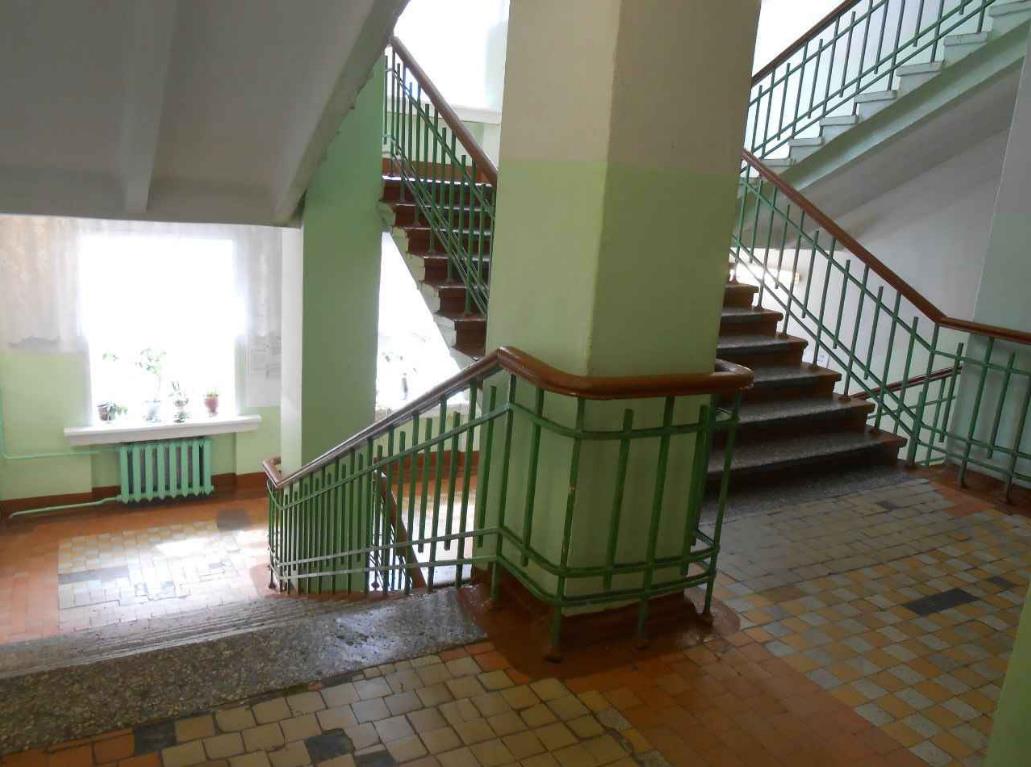
Aleksandra Firuleva, August 2014
Now, if you go down the middle flight, this was the first floor lobby. Now the photo shows the second or third floor. The middle flight of the 1st floor of the staircase led to the main entrance. Here stood the coffin with Zina.

Aleksandra Firuleva, August 2014
The descent was an exit to the courtyard, where there was a volleyball court and a small running track. It says “exit”, this was the exit to the courtyard, and not the entrance to the dorm.
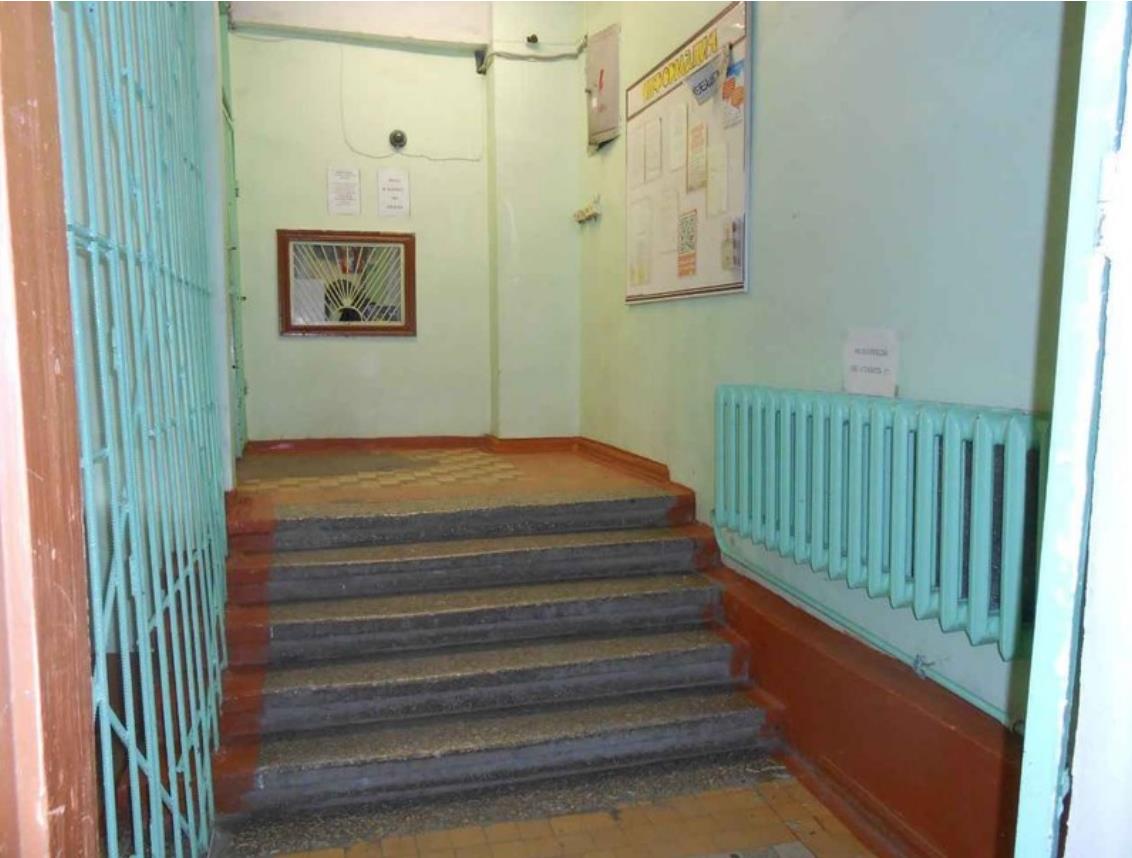
Aleksandra Firuleva, August 2014
This is apparently (I’m not insisting) one of the side entrances that we didn’t use. The dorm was shaped like a "П" in plan, with the "legs" forming a courtyard. Both "legs" had spare entrances.
The interior of the 531 room is completely different from what it was in our time. Four beds stood along the walls, opposite in pairs. Between them there were 4 bedside tables, in the center there was a common table and 4 chairs. And in your photo, it looks like there is a room for two, or even one! With a refrigerator!!
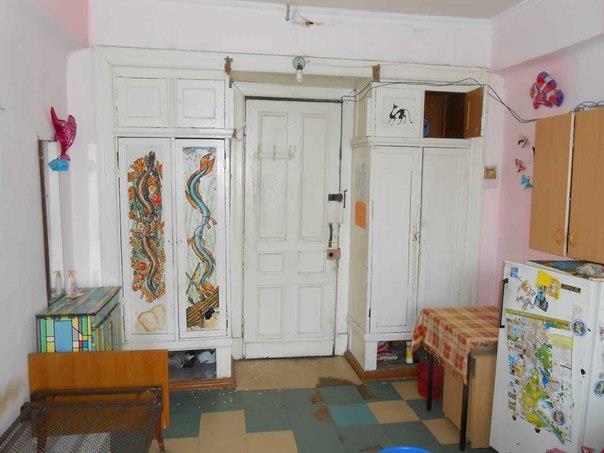
Aleksandra Firuleva, August 2014
- 16 -
I am sending you the interior of room 301, where I lived. The furniture is standard for all rooms. You can see that right at the entrance there is a bed, a common table, a lot of chairs and very small passages between the beds and the table. To expand the "living space" we placed my bed parallel to the window. The aisles have become larger.
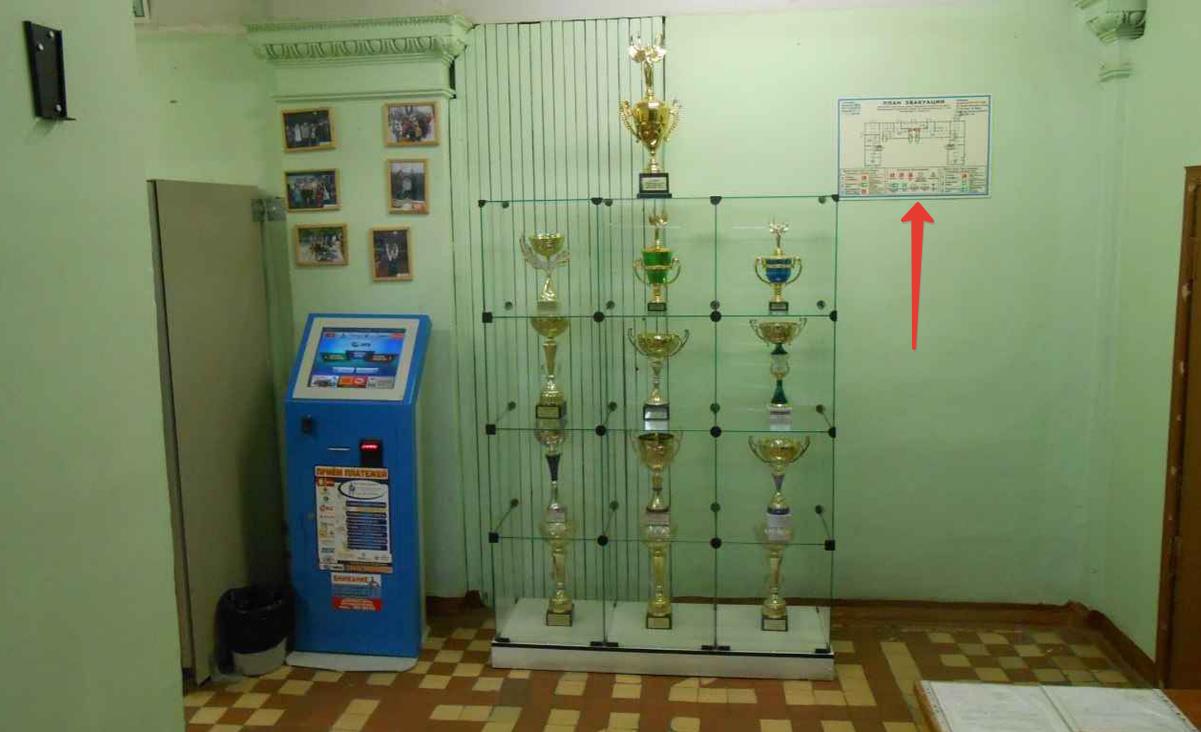
Aleksandra Firuleva, August 2014
In the photo there is an evacuation plan hanging on the wall. I zoomed in and saw that the front entrance we used was missing. There is some kind of fence visible there. And this was the foyer. This is where Zina’s coffin stood. The dorm has 4 entrances: two central and two side (at the "legs").

Evacuation plan
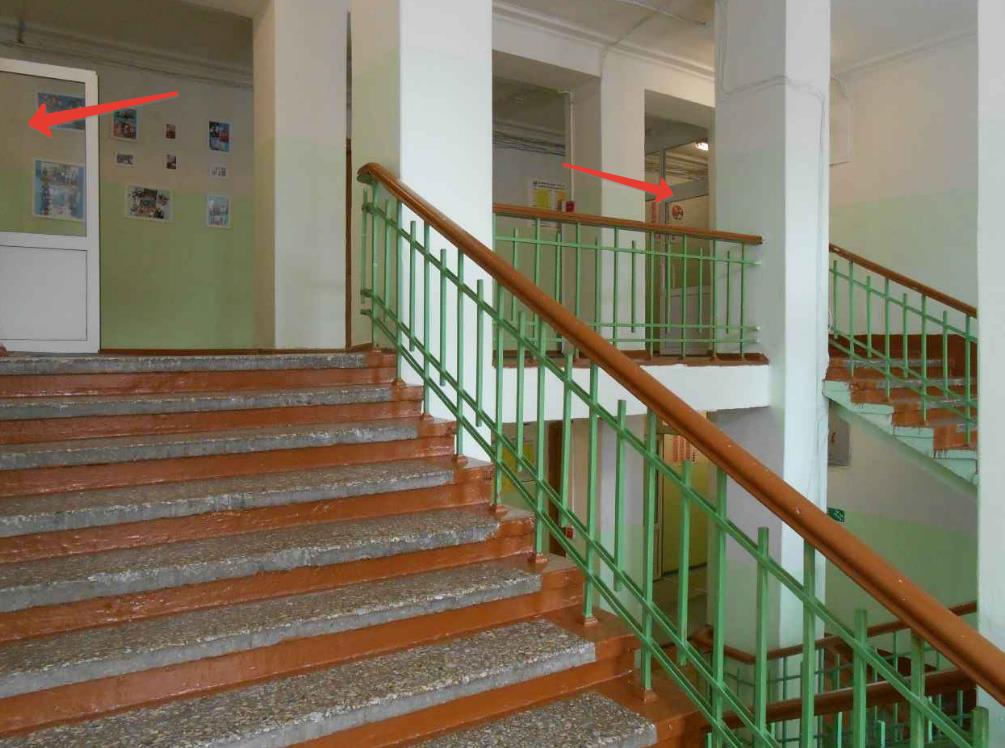
Aleksandra Firuleva, August 2014
By chance I looked again at the first three photos of our dorm that you sent me, and guessed why I didn’t recognize it. The photo shows the exit to the 5th floor. But in our time there were no glass partitions in the corridor.
In general, a lot of water has passed under the bridge in 55 years!!
There comes a moment for any person when he clearly begins to understand that old age has approached. For an athlete, this is the moment when he feels that it is too late to enter the ring (platform, ski track, court) and, most importantly, useless. You are no longer interesting to your fans, you can no longer surprise and delight them with your new records. You no longer have the strength or skill for this. Some perceive this very painfully, others are self-critical enough to pretend that nothing special is happening, that these are the laws of nature. Your former fans already have other favorite stars, who do not yet realize that they are also temporarily loved. But this phenomenon also occurs for non-athletes! This is not surprising; such is the fate of all living people. It is important to understand this yourself, and not wait until you are asked to make room for someone else. I don’t want to, but I have to!
You can discuss this topic on Dyatlov Pass Forum.
Vladimir Askinadzi

